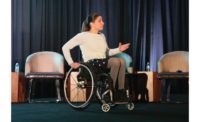This week’s ENR Contractor Business Strategy story about the new RoadX program piloted by the Colorado Dept. of Transportation illustrates what can be achieved when everyone—and everything—is in gear, listening, innovating and collaborating for the public good.
“The goal of RoadX is to capture and partner with the private sector in bringing formative technologies to enhance Colorado’s transportation system,” CDOT Director of Communications Amy Ford told ENR.
CDOT created the robust technological think-tank via a public-private partnership that brings together some of the biggest consulting brains in the industry—firms that are usually keen competitors—and asks them to work collaboratively for a common purpose: to make our roads safer, smarter and cheaper to build and maintain.
In this case, the “big brains” enlisted by CDOT include transportation gurus from AECOM, CH2M and Atkins. CDOT calls them its “RoadX champions.”
“They are our brains,” says Ford. “They help us think through and identify projects and areas we want to go into. And if they have an idea, they get first dibs on doing it.”
The ideas rise from the larger goal of creating “intelligent mobility systems,” not just bigger freeways and more rail lines. That means figuring out how to get vehicles to talk to each other; designing roadways that communicate with cars and trucks, including recharging their batteries as they drive on them; highways that routinely route drivers away from traffic jams, and, above all else, moving the country toward an injury-free transportation future.
Most of these innovations won’t be coming in a recognizable way to your city or neighborhood any time soon, but they are coming, experts assure us. “In the next 10-15 years, we will see upwards of three million connected vehicles on the roads,” Ford says.
Other changes will be less noticeable, but nonetheless effective: lighting improvements, vehicle-safety upgrades, improved pavement quality and lifespan, better wayfinding and road-to-driver messaging done in real-time. Some of those already exist, of course, but only in some states and mostly in urban corridors.
RoadX is an example of how technological innovation should work because it’s not just about new bells and whistles. The program emphasizes listening to public input and then educating people about the possibilities. The role of the RoadX champions has three parts: outreach to innovators, evaluation of ideas and encouraging people to submit new ideas, says Atkins RoadX champion Jim Hanson.
“The real challenge,” he says, “is with the human component of it. That’s a big part of RoadX. It’s all being done for the public good as a form of ‘social listening.’”
ENR will continue to listen as well. We will follow the evolution of the RoadX program and the technologies that arise from it, especially as those ideas and collaborations migrate to other DOTs and public agencies. The CDOT experiment is just the start of a “long, strange trip” into the future of American mobility.




Post a comment to this article
Report Abusive Comment